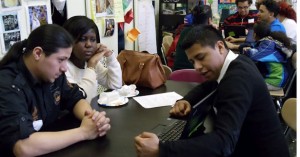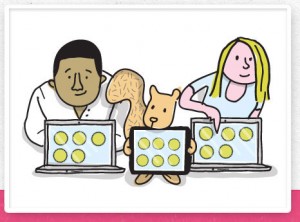
Welcome back! In our first post, we told you about Connected Foundations, a digital literacy program funded by the US Department of Commerce’s Broadband Technology Opportunities Program (BTOP) and managed by the NYC Department of Education and the NYC Department of Information Technology and Telecommunications.
In this post, we’ll describe the “badged and blended” formula we use in courses for NYC high school students. What does “badged and blended” mean? Instructional content in our online platform, BadgeStack, is grouped into badges that students earn as they demonstrate competencies, and our academic courses are designed for blended learning environments that incorporate both technology and face-to-face instruction and interaction.
What’s the big deal with badges?
 To kids, badges are fun and different. More important to us, badges offer schools a way to pinpoint and make explicit the mastery of skills and knowledge. Badges can be both goalposts and trackers; the badges make clear what students will know and be able to do if they complete a given course, and badges show students (and their peers) what progress they have made and provide them with a sense of momentum as they move through a course.
To kids, badges are fun and different. More important to us, badges offer schools a way to pinpoint and make explicit the mastery of skills and knowledge. Badges can be both goalposts and trackers; the badges make clear what students will know and be able to do if they complete a given course, and badges show students (and their peers) what progress they have made and provide them with a sense of momentum as they move through a course.
We are not (yet) suggesting that schools replace grades with badges. Our students earn their badges but still receive grades as they always have. But it is not a great leap to consider how badges might serve as a more useful indicator of mastery than traditional grades ever could be.
Think of it this way: which gives you more information: a ‘B’ in Global Studies, or a set of badges that mark achievement with academic content and methodologies such as: World War I, World War 2, British Imperialism in India, Apartheid in South Africa, Reading Primary Sources, Analyzing Multiple Perspectives … you get the idea.
Badges for learning have gotten lots of attention over the past couple of years in the K-12 and higher education communities. Here’s a recent piece from MindShift that discusses badging. Even the Chronicle of Higher Education has jumped into the fray with an article entitled Grades Out, Badges In (subscription only) in which the author asks “What if we got rid of grades?” The piece calls out limitations and difficulties of traditional grading, and explores the possibilities of badging as a replacement system. Furthermore, the rise of MOOCs and other new opportunities for learning has created a strong need to recognize and accredit learning in a meaningful way.
Students as active learners
We use “badged and blended” courses as the coin of trade to spark student motivation—and sometimes teacher motivation—and to awaken students’ ideas about themselves as active learners. Our courses ask much more from students than passive note taking and test taking. Students in our courses earn badges for independent and collaborative research, for perfecting academic writing forms they will need for other classes, and for creating multimedia presentations to share their ideas. Along with content knowledge, students gain facility with digital literacy, goal setting, self-direction, web research, writing and revision, collaboration, and presentation—many of the skills most needed for success in higher education settings, and most desired by today’s employers.
Some students object when they first find themselves in the driver’s seat in a badged and blended academic course. “Why can’t the teacher just teach, and I’ll take notes?” We tell them: “This course does ask more from you. It also gives you much more education than you’ll typically receive in a traditional class.” Fortunately, many of our most vocal critics do come around, reporting at the end that it was a worthwhile endeavor. See this interview with Yali, a student who took one of our Regents prep English courses:
Rewarding academic and personal behaviors
As we discussed in our last post, students in our courses receive badges that recognize their mastery of specific competencies. Our badges fall into two categories: content-specific academic badges, and reward badges that map to a broad range of academic and personal behaviors that lead to better outcomes on the path to college and career readiness.
Each course contains several “levels,” equivalent to units of study. To make progress in a course, students need to “level up” by completing a series of content-related badges as well as by acquiring points tied to the reward badges. When students level up, their points return to zero, and they must identify a new set of behaviors to work toward (or continue working in areas in which they still need to improve) in each new level.
The courses share a common set of reward badges, so the behaviors can be reinforced across subject areas. Along with a badge series on exponential equations (Intro to Algebra) or Critical Lens Essay (Regents-prep English), students need to earn reward badges for general academic skills and behaviors that will serve them well in whatever educational or employment setting they enter in the future.
Students might choose to work toward badges that reward such valuable efforts as persisting through challenging material, gaining technology skills, attending to precision in their calculations, evaluating research sources, regulating their emotions when they are faced with a struggle, or collaborating effectively on a project. Teachers can also add their own reward badges, such as for an out-of-school volunteer project.
Winning hearts and mind(set)s
Through badging, we also hope to promote a “mastery orientation” (see Carol Dweck’s work on mindsets) in which incremental progress and the effort that goes into learning are more valued than grades or completing work as quickly as possible. We want to free students from the notion that schooling is all about either getting high scores or avoiding failure. By allowing students some degree of choice in what they do and decoupling their work from regimented, class-wide progress through courses, we try to give students a sense of agency and control over their own learning.
In their book Ready, Willing, and Able: A Developmental Approach to College Access and Success, Mandy Savitz-Romer and Suzanne Bouffard emphasize the power of helping students set long-term goals that are real and motivating. The challenge, then, is to break these large goals into meaningful sub-goals that give structure and purpose to what may otherwise feel like a grind. In short, we must help students to see how various short-term tasks and skill-building map to larger goals.
We realize that changing student mindsets is a lofty enterprise, but we believe strongly in the value of integrating these concepts with academic coursework and not leaving them to the domain of advisory or guidance. We hope this gets students thinking more explicitly and strategically about what it takes to succeed in anything, and also helps them start to gain a sense of their own strengths and weaknesses as thinkers, as project leaders and collaborators, as researchers, as presenters, as members of a community.
How badges play in classrooms
In our next post, we will visit and discuss classrooms that use our badges and blended courses—with an eye to showing the badging system in play, and fleshing out some of the fruitful variety we see in how teachers use our courses. Stay tuned!
Want to learn more about digital badges for learning?
- Check out this interview with badging guru Jonathan Finkelstein of LearningTimes, the creator of BadgeStack
- Explore Mozilla’s Open Badges Initiative
- Read a recent New York Times article called Show Me Your Badge: “Information-age credentials may be the first serious competitor to traditional degrees since college-going became the norm.”
- Read a recent Education Week piece called “Digital Badges” Would Represent Students’ Skill Acquisition: “Initiatives seek to give students permanent online records for developing specific skills”
 As Instructional Designer for Connected Foundations from NYCDOE Office of Postsecondary Readiness, Joy Nolan works on course content, implementation, teacher supports, PD, & alignments. She’s a text complexity fanatic and a NYCDOE Senior Common Core Fellow, helping to align instructional materials to the Common Core Standards. Previously at Scholastic Education Group, she worked on Reading/ELA/Math programs focusing on Critical Thinking & College/Career Readiness for struggling students: Expert21, CCSS-aligned READ 180 NEXT GEN, MATH 180. She thinks badging is, will be, or should be the next gold rush of education.
As Instructional Designer for Connected Foundations from NYCDOE Office of Postsecondary Readiness, Joy Nolan works on course content, implementation, teacher supports, PD, & alignments. She’s a text complexity fanatic and a NYCDOE Senior Common Core Fellow, helping to align instructional materials to the Common Core Standards. Previously at Scholastic Education Group, she worked on Reading/ELA/Math programs focusing on Critical Thinking & College/Career Readiness for struggling students: Expert21, CCSS-aligned READ 180 NEXT GEN, MATH 180. She thinks badging is, will be, or should be the next gold rush of education.
 Michael Preston is the Director of Blended Learning Strategy for the NYC Department of Education’s Office of Postsecondary Readiness, where he directs programs to support student development of digital literacy skills and teacher use of blended learning and mastery-based approaches. Previously, he worked at the Columbia Center for New Media Teaching and Learning and taught at Teachers College, where he received a Ph.D. in Educational Psychology.
Michael Preston is the Director of Blended Learning Strategy for the NYC Department of Education’s Office of Postsecondary Readiness, where he directs programs to support student development of digital literacy skills and teacher use of blended learning and mastery-based approaches. Previously, he worked at the Columbia Center for New Media Teaching and Learning and taught at Teachers College, where he received a Ph.D. in Educational Psychology.


